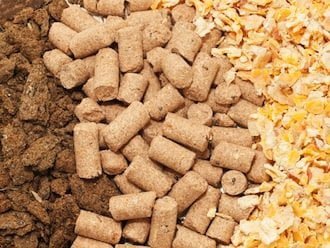There are several different methods of processing. First, raw materials will be screened to remove particles that are either too small or too large, thereby cleaning the raw material. Some materials, like oat hay, are simply chopped up before being included. Whole cereal grains like maize can be cracked, rolled or crimped. Tough seed coats are de-hulled to crack them and allow access to the seeds inside. Some raw materials are cooked to remove negative factors. Soya, for example, is cooked to remove the trypsin inhibitors it includes as they would interfere with protein digestion.
Here is some useful terminology to keep in mind when referring to methods of processing raw materials.
| Ammoniated | Combined or impregnated with ammonia or ammonium compounds. |
| Chopped | Particle size reduced by cutting. |
| Cleaned | Undesired materials removed using screens, magnets or forced air. |
| Condensed | Reduced to a more dense form by removing moisture. |
| Cracked | Particle size reduced by a combined breaking and crushing action. |
| Crimped | Feed rolled using grooved rollers. |
| Cured | Feed preserved by drying, chemical additives or other preservation methods. |
| De-hulled | Grains, fruit or nuts of which the seed coat or outer shell has been removed. |
| Dehydrated | Moisture removed by heat. |
| Ensiled | Plant materials preserved by anaerobic fermentation. |
| Exploded | Grain kernels swollen to several times their original size by first steaming under pressure to force moisture into the kernels, and then exposing to air. |
| Extracted | Fat or oil is removed by heat and mechanical pressure (mechanically extracted) or by organic solvents (solvent extracted). |
| Extruded | Feed forced through narrow openings under pressure. |
| Fermented | Feed subjected to an aerobic or anaerobic process in which yeast, mould or bacteria act to produce alcohol, acids, B complex vitamins or antibiotics. |
| Flaked | Feed rolled or cut into flat pieces with or without prior steam conditioning. |
| Ground | Particle size reduced by mechanical shearing, wearing or impact. |
| Irradiated | Feed treated, prepared or altered by exposure to a specific level and duration of radiation. |
| Micronised | Feed subjected to dry heat by microwaves emitted from infrared burners, followed by rolling. |
| Mixed | Feeds combined by agitation to a specified degree of dispersion. |
| Pearled | Process of reducing de-hulled grains into smaller smooth particles by machine brushing or abrasion. |
| Pelleted | Feed compressed into a circular or cubic mass, forced through die openings by a mechanical process and cut at predetermined lengths. |
| Popped | A commercial process to improve appearance and palatability of beans; promoted as a method to improve protein digestion. |
| Rendered | The process of removing and/or clarifying one substance (for instance fat, water) from another, either through the use of heat or by pressing and draining a solid residue of cooked material. |
| Roasted | Feed heated to a desired temperature in an oven for a period of time. Roasting increases the availability of carbohydrates and may reduce protein breakdown in the rumen. |
| Rolled | Grain passed between a set of rollers, splitting the coarse outer grain shell. |
| Shredded | Similar to chopped, except feedstuffs are cut longitudinally rather than cross-wise. |
| Steamed | Ingredients treated with steam to alter physical and/or chemical properties. |
| Steeped | Feed soaked in water or other liquid. |
| Textured | A ration containing fine materials in a pelleted form, mixed with coarser ingredients. |
Text: Dr Marion Young


